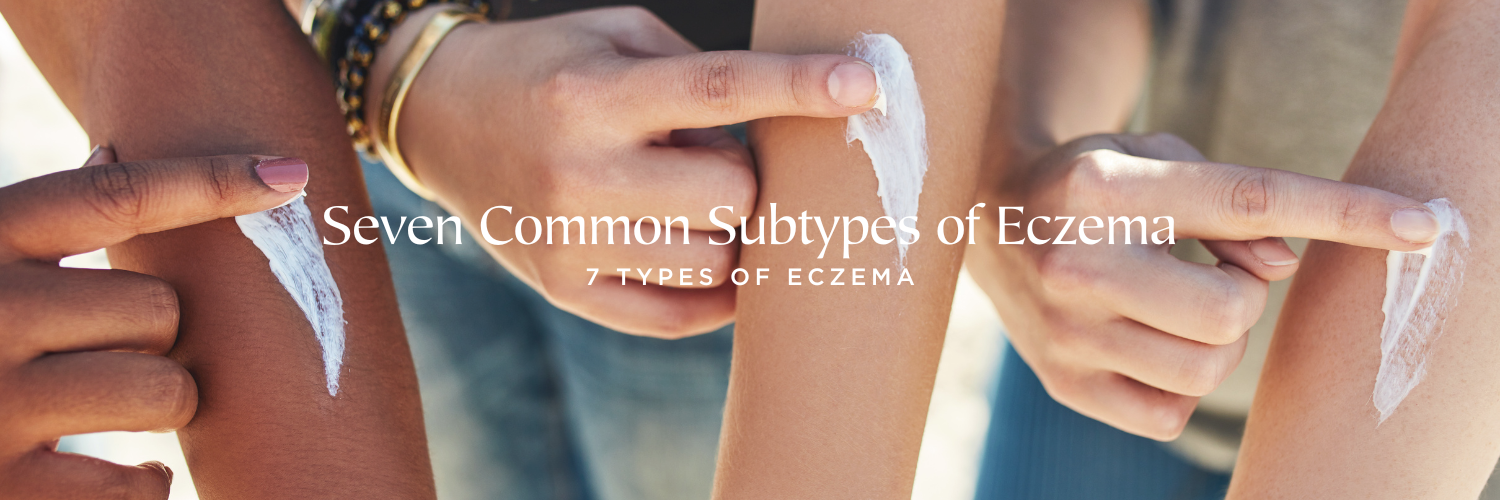
7 types of Eczema
Seven Common Subtypes of Eczema
We often hear the term eczema used interchangeably with atopic dermatitis. Dermatologically, though, eczema is not a singular diagnosis but an umbrella term that encompasses various skin conditions, and atopic dermatitis is just one of many types.
Broadly speaking, eczema is characterized by visible traits like redness, bumps, blisters, and weeping lesions. The word "eczema" has roots in Greek, from the word eczema, composed of ekzein (boil over, break out), but each unique sub-category of eczema has different sets of causes, symptoms and skin morphology.
As you think about treatment for yourself, you'll find that recognizing each kind of eczema and its own set of triggers and treatment makes a vast difference in your prospects for healing.
Seven Common Types of Eczema
Irritant contact dermatitis
Did you know that anyone can get eczema? This type can afflict all people of all ages, who have no pre-existing genetic disposition. Getting it is as easy as washing one's hands excessively each day. In this case, even water works as an irritant to the skin; the process of wetting, drying and rubbing on repeat damages the skin barrier. During the global COVID-19 pandemic, many experienced roughness of skin, itching and discomfort due to the hand-washing protocols that we undertook to prevent spreading germs.
Allergic contact dermatitis
About 1 in 5 people can get allergic contact dermatitis. It's caused by an allergic reaction to a specific substance, which can be to any chemical or natural ingredients. For example, Neosporin, tea tree oil or nickel in jewellery are all equal in this case; it depends on your unique body. The skin responds by itching and having a rash about a day later. The affected area has a blister-like appearance and can have a sort of outline—showing where the allergic substance came into contact with your skin. Even products that you've used for years without issue can trigger this kind of dermatitis! Simply removing the trigger will allow the skin to start healing.
Nummular dermatitis
This one shows up as coin-shaped eczema spots that are extremely itchy. The spots can be scattered across the entire body. They have a typical configuration and distribution, but at this time, there isn't as much known about it. Triggers can include insect bites, a worsened contact dermatitis incident, or extremely dry and sensitive skin. Thankfully, it does respond to treatment protocols and can be managed with your preferred combination of natural products and topical steroids.
Atopic dermatitis
Atopic dermatitis is the most common type of eczema, and we've talked about it a lot here at Sade Baron. It affects over 9.6 million children and about 16.5 million adults in the United States.
This chronic condition can come and go for years or throughout life and can overlap with other types of eczema. It's characterized by chronic, itchy, inflammatory skin and symptoms can appear in large red bumpy patches all over the body. As we inevitably react to the discomfort, frequent scratching leads to thickening and hardening, or lichenification, which appears as tough and leathery skin.
Research has shown that an overactive immune system plays a part in this form of eczema. With a similar mechanism to food allergies, and seasonal allergies, the overactive immune system increases general sensitivity and can lead to additional issues. Your skin can react to environmental changes. Wildfires and their decline in air quality will make atopic dermatitis worse, and the overall sensitivity of the skin makes this a hard condition to manage.
Since skin with atopic dermatitis is more prone to other kinds of exacerbating issues, it needs gentle care, gentle products, and attention to one's lifestyle factors which can increase inflammation—such as stress, diet, and sleep.
Xerotic dermatitis
Skin with this type of eczema looks and feels unbearably dry. It can arise at any time of year, but it’s especially common in winter when the harsh winds and low humidity become a daily challenge. You may know of it as the "winter itch.” For this common seasonal condition, thick, rich lotions full of nutrients and oils impart a massive benefit. Immediately moisturizing after a bath will help to lock in moisture and restore the skin barrier's lipid balance. Petrolatum-based creams can also be very helpful to prevent moisture loss.
Stasis dermatitis
This form of eczema arises when a part of the body, such as the legs, undergoes swelling and the veins aren't able to carry blood through this area well. As the circulation weakens, and enters a kind of stasis, the skin begins to show symptoms, which apart from the very itchy eczema and crusting of the skin, also include hyperpigmentation, varicose vein development, and pitting edema. For this type of eczema, a plan with a doctor is important to manage not only the skin symptoms but the other underlying issues that are contributing to low blood circulation.
Seborrheic dermatitis
Known as cradle cap in kids, it appears in adults as a rash that happens frequently in areas of sebaceous glands—areas where your body produces oil. The cause of this type of eczema hasn't been confirmed, and the prevalence in the population is about 3%. It causes scaly patches, inflamed skin and stubborn dandruff. It is frequently seen on the face, sides of the nose, eyebrows, ears, eyelids and chest.
Knowing what kind of eczema you're battling with can help you target and hone your daily rituals for the best results.
Our dermatologist-tested Bond | Healing Body & Hand Salve was formulated to support sensitive skin that needs a deep dose of moisture to help reduce itching, crusting, extreme dryness, irritation and inflammation. Our oat oil and calendula herbal oil combo helps promote skin healing and calms swelling, while kokum and mango butters in the formula provide lipid support to a damaged skin barrier.
Sources:
National Eczema Association. (2023, June 16). Introducing the 7 Types of Eczema (and What to Do About Them) [Video]. YouTube. https://www.youtube.com/watch?v=ue12XjkOV_E
